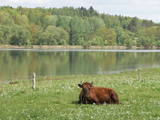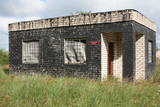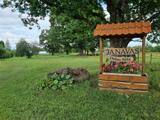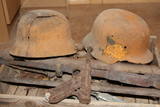| Нo | Название | Описание |
|---|---|---|
|
The nature park in the Daugava River valley is the only place between the cascades of the Daugava hydroelectric power plants there is still a chance to see the Daugava River valley and the ravines of its tributaries as they appeared before the area was flooded so that the power plants could be constructed. Particularly lovely views are found on the right bank of the river near the Aizkraukle church and castle hill. Forests, meadows, origins of streams and small dolomite cliffs in this area are all protected biotopes. Leisure facilities have been installed on the Aizkraukle castle hill, and the Aizkraukle castle ruins are not far away. |
||
|
The smoke sauna is an important part of everyday life in the Võru community in Estonia. It is the centre of a rich set of traditions including the actual bathing customs, the skills of making bathing whisks, building and repairing saunas, and smoking meat in the sauna. The sauna is a building or room heated by a stove covered with stones and with an elevated platform for sitting or lying. It has no chimney, and the smoke from the burning wood circulates in the room. People usually go into the sauna together and remain until they are sweating. Water is thrown on the heated stones to produce hot steam-laden air and bathers beat their bodies with whisks to remove dead skin and stimulate blood circulation. After sweating, whisking, relaxing and possible healing procedures, people cool themselves outside and rinse their bodies with water. The procedure is then repeated. The smoke sauna tradition is primarily a family custom, usually practised on Saturdays, but also before major festivals or family events. Its main function is to relax the body and mind. Families take turns hosting each other. Usually an older family member is responsible for preparing the sauna, accompanied by the children who gradually acquire the necessary skills. The smoke sauna tradition is part of the UNESCO Representative List of the Intangible Cultural Heritage of Humanity. |
||
|
В самом центре Лахемааского национального парка есть своеобразное место- ремесленный хутор Яаниоя. Окантованная камнями дорога ведет к семейному дому желтого цвета, рядом место для костра и палаток, уникальная открытая кухня, старое большое бревенчатое здание, баня и кузница. На хуторе проводятся творческие лагеря, курсы рукоделия, сказочные игры, знаменательные дни Эстонского народного календаря и мастерские для всей семьи. В продаже ясноглазые тряпичные куклы, лоскутные изделия мадам Яаники и своеобразная ручная работа. |
||
|
Радиотехническая рота в Лужня во времена Советского Союза входила в состав береговой погранохраны. Хороший обзор на когда-то военный комплекс открывается с автостоянки в центре Лужня. Отдельные здания используются в качестве жилых зданий.
|
||
|
Taka izveidota Limbažu Lielezera ZA galā, tā ir 3.6 km gara vienā virzienā. Ezeru ziemeļu galā izbūvēts putnu novērošanas tornis. Izbūvēts bērnu rotaļu laukums, labiekārtotas atpūtas vietas, izveidota laivu piestātne. Pāri Donaviņai izveidots gājēju tiltiņš uz pontoniem. |
||
|
В хозяйстве выращивают лекарственные чаи из змееголовника, эхинацеи, мяты, лаванды и др. растений и производят косметику - крема «Беате» и «Васильковую цветочную воду». Предлагают познавательную экскурсию, угощают вкусным чаем. Покупка косметики. |
||
|
В этом путешествии вы познакомитесь с разнообразными сельскими хозяйствами региона Курземе и их продукцией. Вкусно и интересно! Выехав из Риги, вы поедете по дороге, которая ведет вдоль Рижского залива через рыбацкие деревушки, где пахнет копченой рыбой. По пути в Талси вы окажетесь в яблоневом саду и в хозяйстве, где из латвийских яблок производят чипсы. Талси популярен не только как город на девяти холмах, но и как место, где производят вкусный сыр «Талсу ритулис». Здесь находится Латвийский сельскохозяйственный музей, где можно узнать все о хозяйствовании на селе с конца 19-го века и до наших дней. Визитная карточка Кулдиги - это мост из красного кирпича через Венту и очаровательный старый город. Далее дорога ведет к морскому побережью для ознакомления с традициями прибрежного рыболовства, копчения рыбы и выпечки хлеба, осмотра уникальных крутых берегов в Юркалне. На обратном пути вы сможете заглянуть на винодельню и посетить хозяйство, где выращивают грибы шиитаке. Познакомитесь с дорогой молока от коровы до готовой продукции и посетите крестьянское хозяйство с родовой историей, берущей начало со времен баронов и усадеб. |
||
|
Atrodas Inciema centrā. Piedāvā maltīti visām ēdienreizēm. Lielas porcijas, garšīgs ēdiens. Iecienīta tuvākas un plašākas apkaimes maltītes ieturēšanas vieta. Klāj galdus. |
||
|
1,2 km garā taka atrodas netālu no vietas, kur Gauju šķērso Vidzemes šoseja (A 2). Izejot taku, var iepazīt vienu no Latvijas augstākajiem dolomītiežu atsegumiem – Randātu klintis, kas paceļas 25 m virs Gaujas. Taka ir apļaveida un tās apskatei nepieciešamas ~ 45 minūtes. |
||
|
The Sunset trail starts in the centre of Saulkrasti town and takes you to the White Dune. Saulkrasti town with its municipal rural territory, occupies a 17km long stretch of coastal land to the North from the river Lilaste and the lake Lilaste. The White Dune stands on the right side of river Inčupe mouth. It is covered by old pine forest. The white, 18m high sand outcrop in olden times served as a landmark for fishermen. The White Dune formed as winds carried the sand from the beach over clay sediments of the Baltic Ice Lake. Some 150-200 years ago, the dune had been drifting as witnessed by several layers of soil buried within it. Local fishermen and farmers at Bātciems initiated afforestation of the drifting dunes. At that time, the 30m high dunes which are now covered with forest, were bare, shifting and even buried a farmstead. To speed up afforestation, mountain pines were planted. The White Dune was partly washed away in heavy storm in 1969, and 4-6m high precipice formed. Now the wind and sand have levelled out the dune surface, it has been fixed with willow-twigs or grown with forest where the largest pines are more than 170-190 years old. The pines are notable with their large trunks and branches, the scars obtained during their lifetime and the typical “crocodile skin” – the bark forms rhombuses resembling those of the reptile’s scales. Scots Pine (Pinus Silvestris) is one of the most common tree species in Latvia. It grows in dry, meagre sandy soil in dunes as well as in marsh. However, it does not stand overshadowing. Forest fires help pines to get rid of competitors as pine endures fire better than other trees because of its thick bark and high crown. The wood exudes resin and burned wounds close soon. Fire cleans space for seedlings of young pines. Pines can live 300-350 years. Ground cover in dune forests is very sensitive. If the sparse vegetation is destroyed, not only the natural biodiversity and landscape is damaged, but also the dangerous shifting dunes can possibly “wake up”. Embryonic dunes, White (yellow) dunes, Grey dunes and Wooded dunes are EU protected biotopes. Grey Dunes are protected by Latvian law as well. |
||
|
Крестьянское хозяйство «Иесалниеки-1» находится в Плявиньском крае Виеталвской волости. Основная сфера деятельности хозяйства – выращивание зерновых (рапс, ячмень, пшеница и травы). Общая площадь – 180 га. Интересен тот факт, что оба брата ведут хозяйство вместе и общими силами обрабатывают более 800 га. |
||
|
Выращивают овощи, лечебные растения и производят мед. На полях хозяйства пасется крупный рогатый скот мясной породы Шароле. Приобретение продукции. Хозяйка поделится опытом и расскажет также о других окрестных биологических хозяйствах. |
||
|
Группам гурманов хозяйка предлагает поучаствовать в различных кулинарных мастерских (2- 3 урока): в «Мастерской сладкой сдобы», «Мастерской сезонных нетрадиционных овощных блюд», «Мастерской пицц», «Приготовление конопляного стака (масла)» и др. Для тех, кто сам не хочет готовить, предлагается неторопливое деревенское угощение с осмотром хозяйства, виноградного сада и рассказами о жизни в деревне. |
||
|
Находится на обочине шоссе Рига – Вентспилс (A10). Летом работает открытая терраса. Латышская кухня: Салат из говяжьего языка, холодный суп, бульон с фрикадельками, «крестьяньчик», свиные ребрышки, картофельные и тонкие блинчики, мусс. Особое блюдо: Харчо от кафе «У Яниса». |
||
|
Хозяйство «Лаздини» – одно из современейших хозяйств в Латвии, находится в северо-западной части Земгальской равнины, в Кримунской волости. В хозяйстве ориентируются на выращивание, первичную обработку и хранение зерновых (около 1100 га). Хозяин Юрис Лаздиньш является руководителем крупнейшей негосударственной организации сельхозпроизводителей в Латвии. По предварительной договоренности, профессионалы в области сельского хозяйства и будущие эксперты могут приехать в хозяйство за обменом опытом. В окрестностях открывается вид на типичный ландшафт Земгальской равнины. |
||
|
В волости Угале в «Силмачи» создан небольшой музей. Вместе с основателем музея Андреем Кейзером можно отправиться на экскурсию к восстановленному месту расположения 2-й роты батальона Рубениса, к бункеру и к местам боев упомянутой военной группы.
|
||
|
Ботанический сад является подразделением Шяуляйского университета. Это самый молодой и самый небольшой по площади ботанический сад в Литве. Сад был заложен в 1958 г. Его общая площадь составляет 6,54 га. |
||
|
Kuģīša piestātne atrodas Ostas ielas malā, kur tai piekļaujas Tirgus iela. „Hercogs Jēkabs” ekskursantus izvizina 45 minūšu garā braucienā (no maija – oktobrim) pa Ventas grīvu, piedāvājot aplūkot Ventspils ostas un vecpilsētas ainavas no citiem skatu punktiem. |
||
|
В кондитерском цехе, находящемся в Рокишкисском районе, изготавливают традиционные литовские сладости – шакотисы и пряники «Грибочки». Здесь проводятся эдукационная программа по выпечке шакотисов и традиционных пряничных грибочков. |
||
|
Ugandi Resto ‒ ресторан со стильным интерьером, вкусной едой и приветливым обслуживанием, который находится в Отепя. Блюда готовятся из свежих, качественных местных продуктов. |
||
























